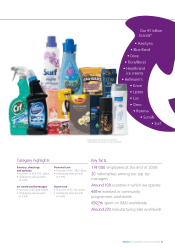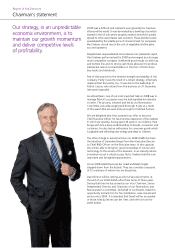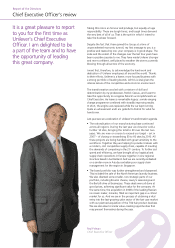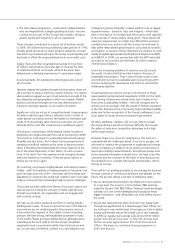Unilever 2008 Annual Report Download - page 16
Download and view the complete annual report
Please find page 16 of the 2008 Unilever annual report below. You can navigate through the pages in the report by either clicking on the pages listed below, or by using the keyword search tool below to find specific information within the annual report.
Vitality through our people
Vital statistics
We introduced a creative way to boost the energy and
enthusiasm of people working in our offices around the world.
InajointmovebyourOccupationalHealthandOrganisation
Effectiveness departments, employees in 21 locations completed
a survey to measure a range of factors that influence their
vitality. The findings were passed to local managers who then
tackledpriorityareas.Forexample,inMexico,whereitisusual
to take an early breakfast and a late lunch, the company Board
at the Boscas office observed that people often resort to
unhealthy mid-morning snacks. As an alternative, they
introduced healthy snacks stations, offering fresh water, soya
drinks, fruit and nuts.
Continued focus on gender
Our Global Diversity Board, led by the Chief Executive Officer,
made steady progress in driving the diversity agenda throughout
the business. Key milestones have been reached with critical
appointments in senior roles including Geneviève Berger becoming
Chief R&D Officer and joining the Unilever Executive (UEx) in
July 2008. Enabling mechanisms include an expanded mentoring
programme, new ways of working that promote life balance and
fostering grassroots involvement through the Unilever Women’s
International Network (U WIN). Initiatives such as the ‘One
More’programmefocusondiversityinteams,whereeveryteam
leader is responsible for increasing diversity through each new
appointment. For the top 100 teams, this means looking for the
opportunity to increase diversity in gender and/or nationality
in every appointment they make.
Talent powerhouse in Argentina
Unilever Argentina cemented its reputation as employer of choice
with a hat-trick of industry awards. For the fourth consecutive
year, it was voted Best Employer by leading business magazine
Apertura, which also ranked it first as the ‘company of dreams’
for students. The business also received the Carlos Pellegrini
Award for best employer, presented by the National Industrial
Association and the Argentine government. Unilever Argentina’s
reputation is largely thanks to a strategy which includes building
long-term relationships with universities to share information
about promising candidates and developing innovative
recruitment processes to differentiate it from other trainee
programmes. This strong position has helped Argentina become
an important talent source for Unilever globally; currently over 80
employees from Argentina are on assignment overseas and
many others occupy regional or global roles.
Unilever is shaped and led by its people who operate within a
framework of shared values and business goals. To attract and
retain the best people, we aim to create an environment in
which all employees can fulfil their potential.
Personal vitality is integral to our vitality agenda. It is brought to
life through many wide-ranging initiatives that promote the
wellbeing of our employees.
Putting safety first
We regard safety as an essential element of a successful and
sustainable business and are committed to providing a safe
workplace. We aim to improve continuously the health,
safety and wellbeing of everyone working for or on behalf of
Unilever. A key measure of our progress in this area is our total
recordable accident frequency rate, which counts all workplace
accidents except those requiring only simple first aid treatment.
In 2008 the rate was 0.21 accidents per 100 000 hours worked,
a decrease of 19% since 2007*.
Feed the world
Anne-RoosCarter,FieldSalesSupportManager,Benelux,was
one of ten Unilever managers to take a secondment to the World
Food Programme (WFP) in 2008. She spent three months in
Indonesia, working on the WFP’s school feeding project, which
aims to ensure pupils get at least one nutritious meal a day. Now
in its second year, the employee secondment programme enables
Unilever people to contribute their skills in placements lasting up
to six months in Africa, Asia and South America. Participants get
a life-changing opportunity to help fight child hunger while at
the same time gaining valuable first-hand experience of living
and working in developing and emerging markets.
Nothing embodies our business as much as our employees. We
grow as a company by growing our people and are committed to
their personal vitality.
* 2008 data is preliminary. It will be independently assured and
reported in our online Sustainable Development Report 2008
at www.unilever.com/sustainability
19%
reduction in total
recordable accident
frequency rate in
2008*
Unilever Annual Report and Accounts 2008 13
























